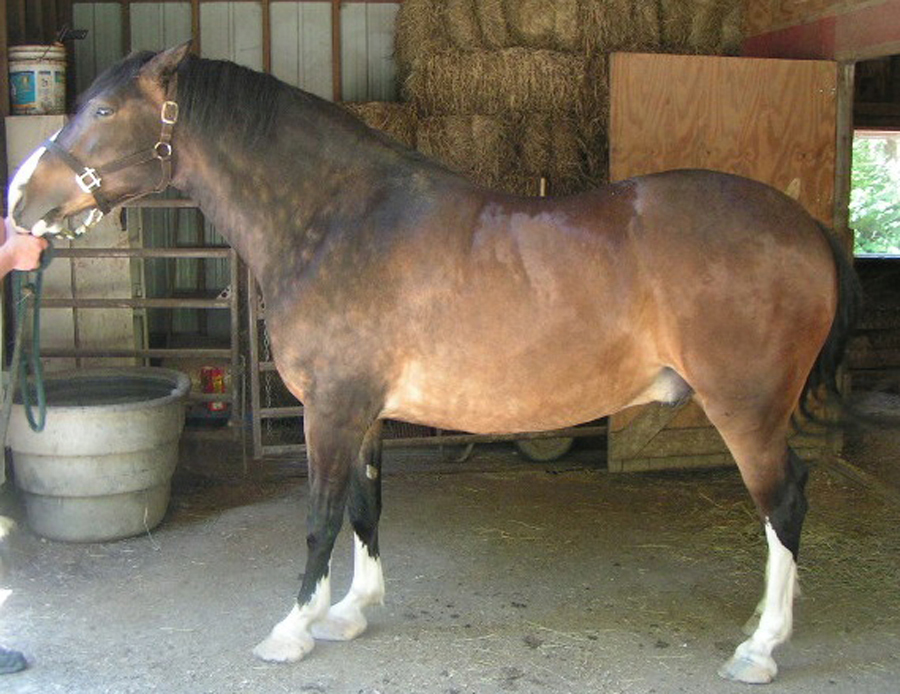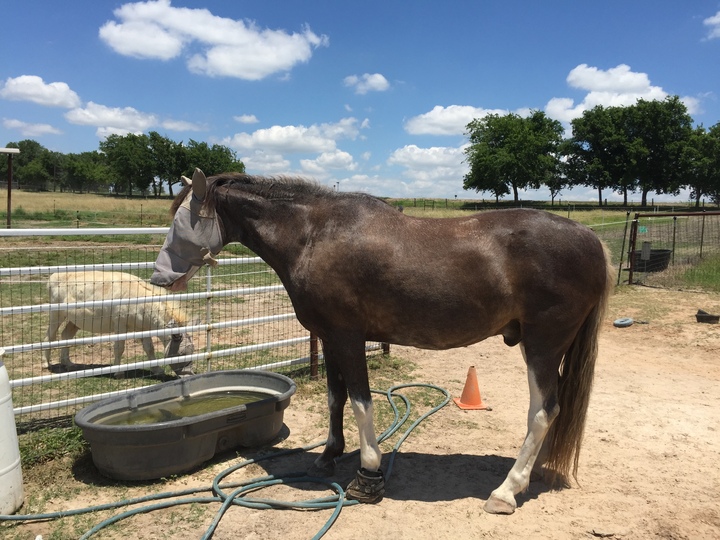Diagnosis of PPID and IR
Equine Cushing's disease, also known as Pituitary Pars Intermedia Dysfunction (PPID), and Insulin Resistance (IR) are distinctly separate conditions. The often overlapping signs and symptoms can make diagnosis difficult.
Pituitary Pars Intermedia Dysfunction (PPID) — Equine Cushing's Disease
PPID/Cushing's Disease is a disorder of the pituitary gland and results in hormonal disturbances. The pituitary gland secretes high levels of the hormone ACTH (adrenocorticotrophic hormone), which stimulates the production of cortisol, a stress hormone.
Recommended Diagnostic Testing for PPID
Endogenous ACTH — a single blood draw to measure the level of endogenous ACTH — is diagnostic for PPID in equines and recommended by the ECIR Group. Horses should not be fasted before ACTH testing. Fasting considerably lowers ACTH. The sample requires special handling for accuracy. Consider TRH Stimulation for suspect horses with normal ACTH. There are seasonal fluctuations to consider for diagnosis of PPID. Please review the section on Seasonal Rise.
In the United States, the ECIR Group suggests Cornell University Laboratory.
From Cornell Endocrinology Submission Guidelines
For ACTH an EDTA plasma tube (usually lavender top) is required for specimen collection. Collect blood to the tube fill volume, gently mix by inversion, and chill immediately by refrigeration or immersion in an ice bath. Separate plasma from cells by centrifugation as quickly within 4 hours for horses. Centrifuge for 5-10 minutes (preferably in a refrigerated centrifuge), transfer the plasma into shipping tube, and freeze immediately. Ship with frozen cold packs using an overnight courier service. Plasma samples should arrive frozen (strongly recommended) or adequately chilled (i.e., kept near 4C at all times).
https://www.vet.cornell.edu/animal-health-diagnostic-center/laboratories/endocrinology
In Canada, the ECIR Group suggests Guelph University Laboratory.
From Page 28, 2009 Lab Services User Guide for Guelph University, E. Endogenous adrenocorticotropic hormone (ACTH) Assay:
Equine HAC. Endogenous ACTH assays are the most useful test for diagnosing pituitary tumors in horses. One limitation is that ACTH is a fragile hormone that requires meticulous care in handling. Blood should be collected in a chilled silicone coated EDTA tube, centrifuged immediately, plasma collected in a plastic (nylon) tube and kept frozen until assayed.
 Skeeter. PPID.
Skeeter. PPID.Examples of other labs world-wide are:
In Australia and New Zealand, Gribbles Pathology and Charles Sturt University
Gribbles will do Leptin testing.
http://www.gribblesvets.com.au/
https://www.gribblesvets.co.nz
http://www.csu.edu.au/vetservices/vdl
In the UK, Liphook Equine Hospital Laboratory
http://liphookequinehospital.co.uk/equine-laboratory/
Other Diagnostic Tests for PPID
 IR horses are often leptin resistant.
IR horses are often leptin resistant.They should not be fed free choice.
The Dexamethasone Suppression Test (DST): The DST measures cortisol response to an injection of dexamethasone. In normal horses, dexamethasone causes profound suppression of cortisol release. Once considered the gold standard for testing, this test has largely been replaced by Thyroid-Releasing (TRH) Stimulation Stimulation Test because of the risk of dexamethasone inducing laminitis in insulin resistant horses.
The Domperidone Response Test involves oral, or possibly intravenous, dosing with the drug domperidone, which causes an approximately 300% rise in ACTH in a horse with PPID but not in a normal horse.
The Thyroid-Releasing (TRH) Stimulation Test: Thyroid releasing hormone (TRH) stimulates release of ACTH. In normal horses the rise is very small but in PPID horses it is pronounced. Samples for ACTH are drawn before and 10 minutes after TRH injection. This test has more false positives than endogenous ACTH but because of its higher sensitivity is a good test for horses strongly suspected to be early PPID horses but which test negative by endogenous ACTH. Results are not reliable during the fall seasonal rise.
Urinary Cortisol:Creatinine Ratio is a test done on urine as a screen for PPID/Cushing's disease. It is not 100% diagnostic, but is highly suggestive. It is more accurate than blood cortisol levels in detecting increased production of cortisol.
Cortisol Rhythm is not diagnostic for PPID/Cushing's Disease, and is considered to have 30%+ false-positive readings.
Equine Metabolic Syndrome (EMS)
Most veterinarians now know what EMS is, and that horses may have EMS without having PPID/Cushing's Disease. A lot of confusion, however, remains about how to correctly diagnose it.
Symptomatically, most but not all, EMS horses have a body condition score of 6 or higher (or a history of being "easy keepers"), abnormal fat collections, such as fatty crests, fat in the eye hollows, or other fat pads; these horses are often brought to the vet's attention because of laminitis.
Blood tests for EMS — insulin, glucose, leptin, and adiponectin
A hallmark of EMS is high levels of insulin — hyperinsulinemia — usually as a result of insulin resistance. This is caused by the failure of insulin-sensitive cells to respond to "normal" levels of insulin.
There are many controversies over how best to test for EMS in equines. There is a dynamic interaction between glucose and insulin that changes over the course of the day. Insulin levels change when the horse eats, sleeps, or exercises. A normal level will depend on conditions of the test. A low-sugar/starch diet can influence insulin results.
The fat-derived hormone, leptin, is also usually abnormally elevated in insulin resistance. There are many other things that can lower or increase leptin — age, weight, sudden changes in nutrient requirements such as foaling, starting an exercise program, differences between breeds. ECIR does not recommend routine testing for this hormone.
Most university and commercial labs offer serum insulin and glucose tests:
https://ahdc.vet.cornell.edu/sects/Endo/
http://www.gribblesvets.com.au/
 Ford. PPID. IR.
Ford. PPID. IR. Crest. Swollen Sheath.
Adiponectin is used in the UK and the EU and may also be tested in the US, however there is no additional value to adiponectin if insulin testing is performed. Adiponectin helps regulate glucose and fat burning, and maintain insulin sensitivity. Low levels are associated with EMS. It has come to be preferred over leptin because it is not influenced by things like weight or exercise, and also because it was the only factor other than insulin levels that predicted laminitis risk.
https://www.ncbi.nlm.nih.gov/pubmed/27363591
Testing in an acutely laminitic horse. It is probably best to refrain from testing for EMS until the acute phase of laminitis has been controlled. There's a good chance that an acutely laminitic horse is going to test positive for EMS, regardless of the cause, because of the pain and stress.
Horses should not be fasted before testing. This is only done for human tests. If a horse is meal fed — periods in excess of 6 hours when the horse has nothing to eat — the first meal after the fast will generate a larger insulin spike than subsequent closer-together feedings, even if the meal is exactly the same. Recent research has confirmed this 20-year recommendation from the ECIR Group.
To avoid a false-positive result, the horse should have hay available at all times the night before and day of the testing. If that's not possible (e.g., a ravenous horse that will inhale as much of anything you put out as quickly as possible), make sure the blood is drawn at least 4 hours after the first meal of the day, keeping some hay in front of the horse until the testing is done.
The horse should not be fed anything except hay prior to testing. The horse also should not be exercised within four hours of the test; avoid shipping before testing if at all possible. Stress and exercise influence glucose, insulin, and leptin dynamics.
 Busy. PPID. IR.
Busy. PPID. IR. Not all PPID or IR horses present with classic symptoms.
Some important facts to remember:
- Most EMS horses do not have an elevated blood glucose. It is helpful, however, to test glucose to make sure the horse has not reached the diabetic range.
- A horse can have EMS and still have an insulin level that is within the lab's normal range. See Lab Reference Ranges and Fasting.
- EMS can be diagnosed from insulin (RISQI); however, as stated above, checking glucose will help make sure the horse has not reached the diabetic range.
Glucose:Insulin Ratio (G:I Ratio)
The upper limit of normal for glucose in a horse that has not been fed anything but hay prior to testing is around 100 mg/dL (5.6 mmol/L) by definition. It is important to also know that the horse could have an insulin result inside the lab's normal range and still have EMS. This is determined by the use of calculations called proxies and supported by abnormal leptin or adiponectin levels.
Based on human studies and data from our group members' horses, we have been using the G:I ratio proxy for many years now. It's very easy to do. Simply divide the glucose result in mg/dL by insulin in uIU/mL. (If your insulin is reported in pmol/L you have to convert it to uIU/mL by dividing by 6.0.) A normal value is 10:1 or higher. The lower the ratio, the higher the laminitis risk.
RISQI
The RISQI is a proxy developed by researchers at the Virginia Polytechnic Institute. RISQI stands for "reciprocal of the square root of insulin". It is calculated by the equation 1/square root of insulin. A normal value is greater than 0.32. A RISQI value of less than 0.2 indicates severe insulin resistance and the horse is at high risk of laminitis.
MIRG
MIRG doesn't measure insulin sensitivity. It measures beta cell responsiveness, or the ability of the pancreas to respond to blood glucose. It is the proxy for AIRg: acute insulin response to glucose. High MIRG = abnormally high insulin response, which likely indicates EMS; but low MIRG is also abnormal and is seen in EMS that has progressed to diabetes.
Recent studies have described horses with normal SI (RISQI) on intravenous testing but high AIRg. It has been hypothesized that the high AIRg on oral testing is coming from incretin release in the intestinal tract. Incretin stimulates insulin release as soon as food hits the intestinal tract and in high secretors can overshoot the mark. However, there is evidence these horses are also overabsorbing glucose, which would mean the high incretin is actually appropriate. Furthermore, if the insulin release was inappropriately high there would be abnormally low glucose, which is not seen.
The abnormally high absorption of glucose and resulting high insulin may be the mechanism by which insulin resistance develops. High levels of a hormone can cause cells to become resistant to its effects.
Low MIRG is seen in horses with pancreatic exhaustion that are not secreting enough insulin and are diabetic.
Information Contained On This Page Adapted From
Equine Cushing's & Insulin Resistance Course
Offered by Eleanor M. Kellon, VMD www.drkellon.com
Diez de Castro E, Lopez I, Cortes B, Pineda C, Garfia B, Aguilera-Tejero E, Influence of feeding status, time of the day, and season on baseline adrenocorticotropic hormone and the response to thyrotropin releasing hormone-stimulation test in healthy horses. Domest Anim Endocrinol. 2014 Jul:48:77-83. https://pubmed.ncbi.nlm.nih.gov/24906932/
Kellon, EM. Diagnosis of Insulin Resistance and PPID, Proceedings of ECIR Group Inc., 2013 NO Laminitis! Conference, Jacksonville, OR, USA. www.ivis.org
Sojka JE, Jackson LP, Moore G, Miller M. Domperidone Causes an Increase in Endogenous ACTH Concentration in Horses With Pituitary Pars Intermedia Dysfunction (Equine Cushing's Disease) http://www.ivis.org/proceedings/aaep/2006/pdf/z9100106000320.pdf
Kronfeld DS, Treiber KH, Hess TM, Boston RC. Insulin resistance in the horse: Definition, detection, and dietetics, J. Anim. Sci. 2005. 83(E. Suppl.):E22 "E31
Treiber KH, Kronfeld DS, Hess TM, Boston RC, Harris PA. Use of proxies and reference quintiles obtained from minimal model analysis for determination of insulin sensitivity and pancreatic beta-cell responsiveness in horses. AJVR, Vol 66, No. 12, December 2005
Olley RB, Carslake HB, Ireland JL, McGowan CM. Comparison of fasted basal insulin with the combined glucose-insulin test in horses and ponies with suspected insulin dysregulation, The Veterinary Journal 252 http://dx.doi.org/10.1016/j.tvjl.2019.105351 1090-0233/� 2019 Elsevier Lt


